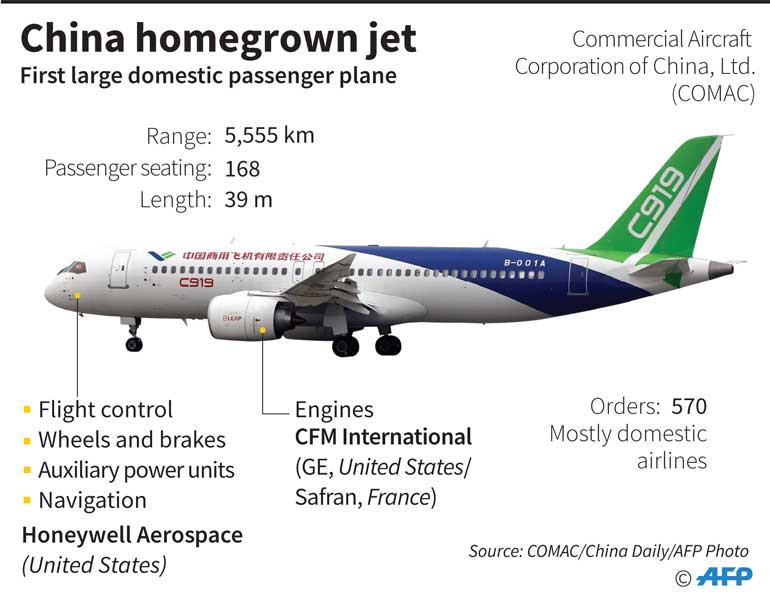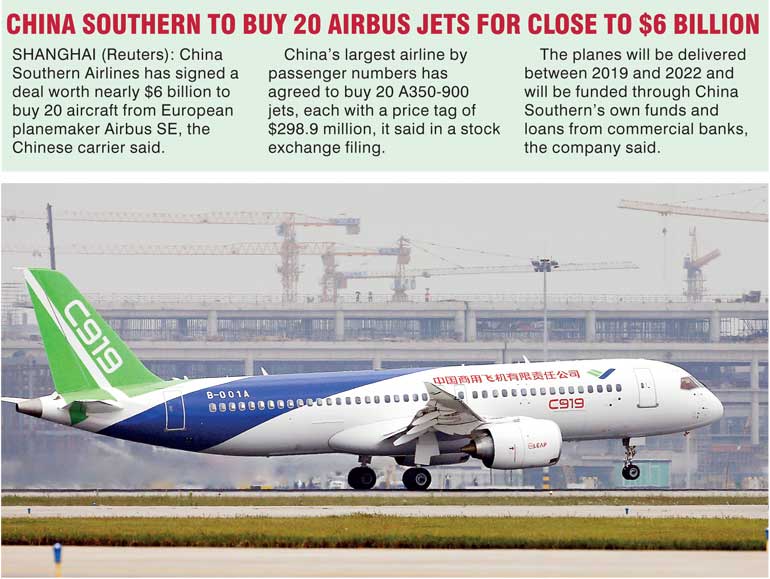Tuesday Jul 01, 2025
Tuesday Jul 01, 2025
Monday, 8 May 2017 00:10 - - {{hitsCtrl.values.hits}}
AFP: The first large made-in-China passenger plane successfully completed its maiden test flight Friday, marking a key milestone on the country’s ambitious journey to compete with the world’s leading aircraft makers.
The narrow-body C919 jet – white with green and blue stripes – disappeared into the clouds after taking off from Pudong international airport in the commercial hub Shanghai as a crowd of thousands cheered. It successfully landed some eighty minutes later.
Built by state-owned aerospace manufacturer Commercial Aircraft Corporation of China (COMAC), the plane represents nearly a decade of effort in a government-mandated drive to reduce dependence on European consortium Airbus and US aerospace giant Boeing.
The flight is the latest sign of China’s growing ambition and technical skill, coming one week after the country launched its first domestically made aircraft carrier and docked a cargo spacecraft with an orbiting space lab.
Before takeoff, CCTV state television said the plane would be tested at an altitude of 3,000 metres (9,800 feet), some 7,000 metres lower than a regular trip, and at a speed of around 300 kilometres (186 miles) per hour.
Top officials, COMAC staff and company partners attended the inaugural flight, which was shown live on state television.
China has dreamt of building its own civil aircraft since the 1970s, when it began work on the narrow-body Y-10, which was eventually deemed unviable and never entered service.
 $1 trillion market
$1 trillion market
President Xi Jinping himself has endorsed the new project, visiting COMAC even before he took office in 2013. The first flight was supposed to take place last year, but it was delayed until now.
His call to arms is emblazoned on the wall of the jet’s production facility: “Accelerate the construction of the world’s top aviation company and continue to make new contributions to develop a strong aviation industry.”
China is a massive battleground for Boeing and Airbus, with the country’s travel market expected to surpass the United States by 2024, according to the International Air Transport Association.
Airbus and Boeing estimate that Chinese airlines will need between 6,000-6,800 aircraft at a total price of around $1 trillion.
The twin-engine C919, whose name sounds like the Chinese word for “everlasting”, can seat 168 passengers in an arrangement similar to other narrow-body jets: three white-velvet upholstered seats line each side of its central aisle.
It has a range of 5,555 kilometres (3,444 miles) and has received 570 orders, almost all from domestic airlines.
COMAC made two planes for the test flight and it expects to produce four more by 2019, said Bao Pengli, deputy head of Shanghai Aircraft Manufacturing Co. – COMAC’s production arm.
The Shanghai-based firm plans to become one of the world’s leading civil aircraft manufacturer in the next three years, aiming to have the C919 and ARJ21, a smaller 90-seat regional jet made by COMAC, both certified to fly internationally.
But it will be sometime before the C919 is ready to compete with the top-selling products of the world’s aviation giants, said Bao.
“The biggest challenge is that the whole manufacturing experience still needs improvement because this is the first time China is making a primary route plane,” Bao told reporters before the flight.
Earning trust
The C919 will need to pass more tests to obtain Chinese airworthiness certification. The Shanghai-based company is also aiming to have the plane certified by US and European regulators.
The ARJ21 plane, which entered service in 2016, several years late, is currently restricted to flying domestic routes as it still lacks the Federal Aviation Administration (FAA) certification that would allow it to fly US skies.
Another challenge for the C919 is earning consumers’ trust, said Shukor Yusof, an analyst with Malaysia-based aviation consultancy Endau Analytics.
“It will take some time for customers around the world to be comfortable buying Chinese airplanes,” he said, adding, “it’s not going to happen in the next ten years.”
“It’s going to be incredibly tough not because it’s not a good product, but because you need to get comfort and credibility to the product among potential clients, potential customers.”

Discover Kapruka, the leading online shopping platform in Sri Lanka, where you can conveniently send Gifts and Flowers to your loved ones for any event including Valentine ’s Day. Explore a wide range of popular Shopping Categories on Kapruka, including Toys, Groceries, Electronics, Birthday Cakes, Fruits, Chocolates, Flower Bouquets, Clothing, Watches, Lingerie, Gift Sets and Jewellery. Also if you’re interested in selling with Kapruka, Partner Central by Kapruka is the best solution to start with. Moreover, through Kapruka Global Shop, you can also enjoy the convenience of purchasing products from renowned platforms like Amazon and eBay and have them delivered to Sri Lanka.
Discover Kapruka, the leading online shopping platform in Sri Lanka, where you can conveniently send Gifts and Flowers to your loved ones for any event including Valentine ’s Day. Explore a wide range of popular Shopping Categories on Kapruka, including Toys, Groceries, Electronics, Birthday Cakes, Fruits, Chocolates, Flower Bouquets, Clothing, Watches, Lingerie, Gift Sets and Jewellery. Also if you’re interested in selling with Kapruka, Partner Central by Kapruka is the best solution to start with. Moreover, through Kapruka Global Shop, you can also enjoy the convenience of purchasing products from renowned platforms like Amazon and eBay and have them delivered to Sri Lanka.